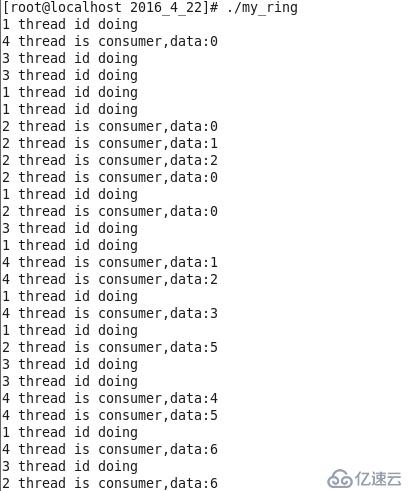您好,登录后才能下订单哦!
死锁产生的四个条件:
1、互斥使用(资源独占)
一个资源每次只能给一个进程使用
.2、不可强占(不可剥夺)
资源申请者不能强行的从资源占有者手中夺取资源,资源只能由占有者自愿释放
.3、请求和保持(部分分配,占有申请)
一个进程在申请新的资源的同时保持对原有资源的占有(只有这样才是动态申请,动态分配)
.4、循环等待
存在一个进程等待队列
{P1 , P2 , … , Pn},
其中P1等待P2占有的资源,P2等待P3占有的资源,…,Pn等待P1占有的资源,形成一个进程等待环路
生产者:生产数据
消费者:消费数据
提供场所:缓冲区,eg:超市
生产者消费者特点:三种关系,两类人,一个场所
三种关系指的是:生产者与生产者之间是互斥关系
消费者与消费者之间是互斥关系
生产者与消费者之间是同步与互斥关系
两类人:生产者,消费者
一个场所:存储数据(此处用带头单链表实现)
单生产者单消费者模式:此例取数据方式为LIFO后进先出,所取数据为最后一个生产的数据(也可选择所取数据为最先生产的数据,可自行选择)
互斥锁相关函数:
#include <pthread.h>
int pthread_mutex_destroy(pthread_mutex_t *mutex);
int pthread_mutex_init(pthread_mutex_t *restrict mutex,const pthread_mutexattr_t *restrict attr);
pthread_mutex_t mutex = PTHREAD_MUTEX_INITIALIZER;
int pthread_mutex_lock(pthread_mutex_t *mutex);
int pthread_mutex_trylock(pthread_mutex_t *mutex);//非阻塞形式获取锁
int pthread_mutex_unlock(pthread_mutex_t *mutex);
//1.使用互斥锁实现
#include<stdio.h>
#include<malloc.h>
#include<pthread.h>
typedef int _dataType_;
typedef int* _dataType_p_;
typedef struct _node
{
_dataType_ data;
struct _node* next;
}node,*nodep,**nodepp;
nodep head=NULL;
pthread_mutex_t mutex=PTHREAD_MUTEX_INITIALIZER;
nodep buyNode(_dataType_ val)
{
nodep tmp=(nodep)malloc(sizeof(node));
if(tmp!=NULL)
{
tmp->data=val;
tmp->next=NULL;
return tmp;
}
return NULL;
}
void init(nodepp head)
{
*head=buyNode(0);
}
void push_list(nodep head,_dataType_ val)
{
nodep tmp=buyNode(val);
tmp->next=head->next;
head->next=tmp;
}
int pop_list(nodep head,_dataType_p_ pval)
{
if(head->next==NULL)
return -1;
nodep del=head->next;
*pval=del->data;
head->next=del->next;
free(del);
return 0;
}
void* product(void* arg)
{
_dataType_ i=0;
while(1)
{
sleep(1);
pthread_mutex_lock(&mutex);
push_list(head,i++);
pthread_mutex_unlock(&mutex);
}
pthread_exit((void*)1);
}
void* consumer(void* arg)
{
_dataType_ val=0;
while(1)
{
sleep(1);
pthread_mutex_lock(&mutex);
if(pop_list(head,&val)==-1)
{
pthread_mutex_unlock(&mutex);
continue;
}
printf("data:%d\n",val);
pthread_mutex_unlock(&mutex);
}
pthread_exit((void*)1);
}
int main()
{
pthread_t tid1,tid2;
init(&head);
pthread_create(&tid1,NULL,product,NULL);
pthread_create(&tid2,NULL,consumer,NULL);
pthread_join(tid1,NULL);
pthread_join(tid2,NULL);
free(head);
pthread_mutex_destroy(&mutex);
return 0;
}//2.使用条件变量实现生产者消费者模式
条件变量:基于互斥锁实现同步与互斥
一个条件变量总是和一个Mutex搭配使用。
一个线程可以调用pthread_cond_wait在一个Condition Variable上阻塞等待,这个函数做以下三步操作:
1. 释放Mutex
2. 阻塞等待
3. 当被唤醒时,重新获得Mutex并返回
条件变量相关函数:
#include <pthread.h>
int pthread_cond_destroy(pthread_cond_t *cond);
int pthread_cond_init(pthread_cond_t *restrict cond,const pthread_condattr_t *restrict attr);
pthread_cond_t cond = PTHREAD_COND_INITIALIZER;
int pthread_cond_timedwait(pthread_cond_t *restrict cond,pthread_mutex_t *restrict mutex,
const struct timespec *restrict abstime);
int pthread_cond_wait(pthread_cond_t *restrict cond,pthread_mutex_t *restrict mutex);
pthread_cond_timedwait函数还有一个额外的参数可以设定等待超时,如果到达了abstime所指
定的时刻仍然没有别的线程来唤醒当前线程,就返回ETIMEDOUT。
int pthread_cond_broadcast(pthread_cond_t *cond);
int pthread_cond_signal(pthread_cond_t *cond);
一个线程可以调用pthread_cond_signal唤醒在某个Condition Variable上等待的另一个线程,也可以调用pthread_cond_broadcast唤醒在这个Condition Variable上等待的所有线程。
#include<stdio.h>
#include<malloc.h>
#include<pthread.h>
typedef int _dataType_;
typedef int* _dataType_p_;
typedef struct _node
{
_dataType_ data;
struct _node* next;
}node,*nodep,**nodepp;
nodep head=NULL;
pthread_cond_t cond=PTHREAD_COND_INITIALIZER;
pthread_mutex_t mutex=PTHREAD_MUTEX_INITIALIZER;
nodep buyNode(_dataType_ val)
{
nodep tmp=(nodep)malloc(sizeof(node));
if(tmp!=NULL)
{
tmp->data=val;
tmp->next=NULL;
return tmp;
}
return NULL;
}
void init(nodepp head)
{
*head=buyNode(0);
}
void push_list(nodep head,_dataType_ val)
{
nodep tmp=buyNode(val);
tmp->next=head->next;
head->next=tmp;
}
int pop_list(nodep head,_dataType_p_ pval)
{
if(head->next==NULL)
return -1;
nodep del=head->next;
*pval=del->data;
head->next=del->next;
free(del);
return 0;
}
void* product(void* arg)
{
_dataType_ i=0;
while(1)
{
sleep(1);
pthread_mutex_lock(&mutex);
push_list(head,i++);
pthread_cond_signal(&cond);
pthread_mutex_unlock(&mutex);
}
pthread_exit((void*)1);
}
void* consumer(void* arg)
{
_dataType_ val=0;
while(1)
{
sleep(1);
pthread_mutex_lock(&mutex);
if(pop_list(head,&val)==-1)
pthread_cond_wait(&cond,&mutex);
printf("data:%d\n",val);
pthread_mutex_unlock(&mutex);
}
pthread_exit((void*)1);
}
int main()
{
pthread_t tid1,tid2;
init(&head);
pthread_create(&tid1,NULL,product,NULL);
pthread_create(&tid2,NULL,consumer,NULL);
pthread_join(tid1,NULL);
pthread_join(tid2,NULL);
free(head);
pthread_cond_destroy(&cond);
pthread_mutex_destroy(&mutex);
return 0;
}//3.使用环形buf存储数据,信号量的使用
信号量相关函数:
信号量(Semaphore)和Mutex类似,表示可用资源的数量,和Mutex不同的是这个数量可以大于1
#include <semaphore.h>
int sem_init(sem_t *sem, int pshared, unsigned int value);
int sem_destroy(sem_t *sem);
int sem_wait(sem_t *sem);//类似P操作
int sem_trywait(sem_t *sem);
int sem_timedwait(sem_t *sem, const struct timespec *abs_timeout);
int sem_post(sem_t *sem);//类似V操作
#include<stdio.h>
#include<pthread.h>
#include<semaphore.h>
#define _SEM_PRO_ 20
#define _SEM_COM_ 0
typedef int _dataType_;
_dataType_ blank[_SEM_PRO_];
sem_t sem_product;
sem_t sem_consumer;
void* product(void* arg)
{
int index=0;
int count=0;
while(1)
{
sleep(rand()%5);
sem_wait(&sem_product);
blank[index++]=count++;
sem_post(&sem_consumer);
index%=_SEM_PRO_;
}
pthread_exit((void*)1);
}
void* consumer(void* arg)
{
int index=0;
while(1)
{
sem_wait(&sem_consumer);
printf("data:%d\n",blank[index++]);
sem_post(&sem_product);
index%=_SEM_PRO_;
}
pthread_exit((void*)1);
}
int main()
{
pthread_t tid1,tid2;
sem_init(&sem_product,0,20);
sem_init(&sem_consumer,0,0);
pthread_create(&tid1,NULL,product,NULL);
pthread_create(&tid2,NULL,consumer,NULL);
pthread_join(tid1,NULL);
pthread_join(tid2,NULL);
sem_destroy(&sem_product);
sem_destroy(&sem_consumer);
return 0;
}//4.多生产者,多消费者模式
#include<stdio.h>
#include<pthread.h>
#include<semaphore.h>
#define _SEM_PRO_ 20
#define _SEM_COM_ 0
typedef int _dataType_;
_dataType_ blank[_SEM_PRO_];
sem_t sem_product;
sem_t sem_consumer;
pthread_mutex_t mutex_product=PTHREAD_MUTEX_INITIALIZER;
pthread_mutex_t mutex_consumer=PTHREAD_MUTEX_INITIALIZER;
void* product(void* arg)
{
int index=0;
int count=0;
while(1)
{
sleep(rand()%5);
sem_wait(&sem_product);
pthread_mutex_lock(&mutex_product);
printf("%d thread id doing\n",(int)arg);
blank[index++]=count++;
index%=_SEM_PRO_;
pthread_mutex_unlock(&mutex_product);
sem_post(&sem_consumer);
}
pthread_exit((void*)1);
}
void* consumer(void* arg)
{
int index=0;
while(1)
{
sem_wait(&sem_consumer);
pthread_mutex_lock(&mutex_consumer);
printf("%d thread is consumer,data:%d\n",(int)arg,blank[index++]);
index%=_SEM_PRO_;
pthread_mutex_unlock(&mutex_consumer);
sem_post(&sem_product);
}
pthread_exit((void*)1);
}
int main()
{
pthread_t tid1,tid2,tid3,tid4;
sem_init(&sem_product,0,20);
sem_init(&sem_consumer,0,0);
pthread_create(&tid1,NULL,product,(void*)1);
pthread_create(&tid2,NULL,consumer,(void*)2);
pthread_create(&tid3,NULL,product,(void*)3);
pthread_create(&tid4,NULL,consumer,(void*)4);
pthread_join(tid1,NULL);
pthread_join(tid2,NULL);
pthread_join(tid3,NULL);
pthread_join(tid4,NULL);
sem_destroy(&sem_product);
sem_destroy(&sem_consumer);
pthread_mutex_destroy(&mutex_product);
pthread_mutex_destroy(&mutex_consumer);
}运行结果显示:

免责声明:本站发布的内容(图片、视频和文字)以原创、转载和分享为主,文章观点不代表本网站立场,如果涉及侵权请联系站长邮箱:is@yisu.com进行举报,并提供相关证据,一经查实,将立刻删除涉嫌侵权内容。